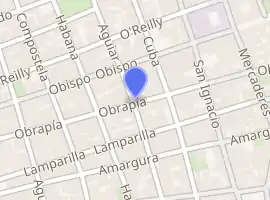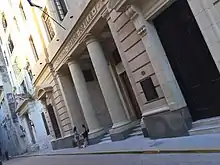Royal Bank of Canada Building, Havana
Royal Bank of Canada Building, Havana is a Neoclassical-style bank building located at corner of Calles Aguiar and Obrapia in Habana Vieja. The ground floor was dedicated to the bank, the other floors to offices that were rented; a floor was added (seventh floor) for a semiprivate restaurant and club.[2]
| Royal Bank of Canada Building | |
|---|---|
 | |

| |
| Former names | Royal Bank of Canada |
| General information | |
| Type | Bank |
| Architectural style | Neoclassical |
| Location | Habana Vieja |
| Address | Calle Aguiar 367 |
| Town or city | |
| Country | |
| Coordinates | 23°08′17.4″N 82°21′09.3″W |
| Current tenants | Tribunal Supremo Popular |
| Construction started | 1917 |
| Opened | 1919 |
| Closed | 1960 |
| Owner | Bank of Canada |
| Technical details | |
| Structural system | Steel frame |
| Floor count | 7 |
| Lifts/elevators | 2[1] |
| Design and construction | |
| Architect | Godfrey Davenport |
| Architecture firm | Purdy and Henderson |
| Website | |
| www | |
Built in 1917, the building was designed by New York-based firm Purdy and Henderson, Engineers, but supervised by Sumner Godfrey Davenport, who would subsequently join the bank in Havana in 1920. In the same year Davenport moved to Canada to become the bank's Chief Architect.[3]
This building would be one of Royal Bank of Canada's 65 branches that existed in the 1920s and twenty four by the time it was forced to close in 1960.[4][5]
Architecture
The facade on the ground floor is of Jaimanitas stonework and the rest of artificial cement stone including all the decorations and cornices, to which a yellow dye was added to accentuate its severity and magnificence. The foundations, columns, architrave and ceiling, the vault, the roof cover are reinforced concrete.
All the interior decorations were made of plaster as well as the use of marble and mosaic used in the pavements, while the Catalan brick was used in the roofing. The metal armor and the glass was used in the carpentry as the doors of streets and interiors were made in cedar. Wrought iron would decorate window openings and stair rails. The access to the different floors was done by means of two electric elevators and a staircase, also having another one for fires.
In 1918, during the construction process, a seventh floor was added to the restaurant and club, specially built for it. This Lunch Club was organized by representatives, bankers, merchants and professionals in general of Havana and worked until 1928 when they decided to occupy the spaces for offices. In 1921 reforms were made on the second floor related to the closing of vain and the construction of a new vault, this time for books. A central court from the second floor, the corresponding portion at the ground floor was closed by a skylight of wired and leaded glass over the banking hall.

Its façade, framed by classical orders, is removed from the sidewalk so that its entrance becomes more accessible and distinguished. Voluminous columns give way to the stairway that led directly to the entrance of the bank, ranking it with respect to the rest of the facades. The building is a large block divided into three bodies, the first formed by the ground floor; the second, for the rest of the floors, and in the last, a large cornice as a finishing touch. The architect Pedro Martínez Inclán made the following observation referring to this type of buildings: "... in general almost all modern buildings, for shops and offices demonstrate a marked influence of New York architecture with its large number of floors, the sobriety of ornaments, the very long vertical lines of its façade, its large cornices and the monotonous distribution of its gaps, which due to climate needs are made in Cuba, are wider".
The Royal Bank of Canada, at the facade level expresses different scales. The use of colossal columns from the basement to the cornice, the ornamentation concentrated on the first floor and the rest is treated as single monumentality showed, in addition to its architectural significance, the bank's hegemony in the finance sector of the city.[1]
References
- "Antiguo edificio The Royal Bank of Canada". Retrieved 2018-10-03.
- "The Royal Bank of Canada (Cuba)". Retrieved 2018-10-02.
- "Davenport, Sumner Godfrey - Biographical Dictionary of Architects in Canada". dictionaryofarchitectsincanada.org.
- Philcovex (4 March 2013). "Postal History Corner: 1939 The Royal Bank of Canada and Rocket Mail".
- "RBC weighs return to 'attractive' Cuba market as U.S. relations warm" – via The Globe and Mail.





